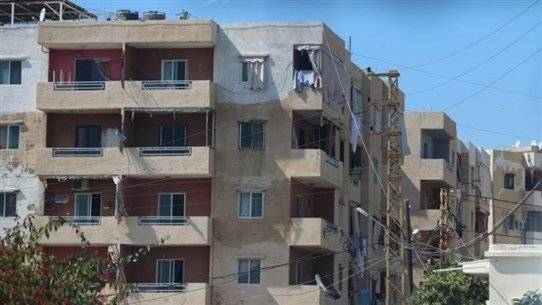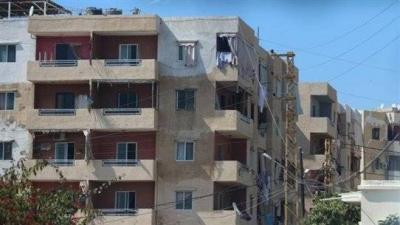The "Mazhar Housing Project" in the Naameh area has been the subject of seven decisions made by the Council of Ministers over the past 22 years, none of which have been implemented to address the issue. Two of its buildings collapsed in 2000, and despite conflicting engineering reports regarding the cost of demolition or renovation, all reports agree that most of the 25 buildings, which include over 500 apartments, are uninhabitable. In 2013, thirteen years after the collapse of two adjacent buildings in the "Mazhar Housing Project" that resulted in nine deaths and dozens of injuries, the state made bold promises to evacuate the project and demolish or restore its buildings at the expense of the owner, Wafiq Mazhar, who was pursued legally and had his movable and immovable assets confiscated to secure the rights of the apartment owners. However, this did not occur.
Today, more than 100 families, mostly from Arab clans and Syrian refugees, live in the threatened apartments, left to their fate even after the roof of one apartment collapsed last year and another collapsed recently, resulting in the death of a one-year-old Syrian infant. The municipality is unable to evacuate the apartments in the building with the collapsed roof due to the lack of alternative housing for the residents, according to Zahir Mazhar, the mayor of Naameh - Haret Naameh.
The Council of Ministers' first decision immediately following the 2000 building collapses was to evacuate the buildings for public safety, but no one dared to implement it. Some buildings were evacuated, only for residents to return months later. Successive interior ministers acted similarly, with Minister Mohamed Fahmy sending a letter to the Council of Ministers stating that he could not provide security assistance to the municipality of Naameh - Haret Naameh "due to security sensitivities," as the buildings had become a hub for wanted individuals, arms dealers, and drug traffickers, according to some local residents. In contrast, the former mayor and current council member Charbel Matar denies this, asserting that "due to the recurrence of security incidents and gunfire in the project, some say there is a security sensitivity, but there would be no security hub if the state fulfilled its obligations." He mentioned that the municipality has followed the matter for years and sent letters to the relevant officials stating its inability to handle this issue both financially and morally, but no action has been taken.
Interior and Municipalities Minister Bassam Mawlawi confirmed to "Al-Akhbar" that he was able to ensure security assistance for the immediate evacuation of the buildings, stressing, "I will not bear the burden of any victim that may fall due to the collapse of the buildings." Therefore, he called for a meeting today with Mount Lebanon Governor Mohamed Makawi, the mayor of Naameh - Haret Naameh, and some concerned parties to discuss the issue.
Contrary to Mawlawi's enthusiasm, other officials have always treated this case as "an investment opportunity," with conflicting reports provided by specialized companies commissioned by the Council of Ministers to study the matter since the collapse of the buildings. In April 2001, "Laseco" submitted a report to the Council for Development and Reconstruction stating that all project buildings needed reinforcement costing $1.8 million, without mentioning demolition. Meanwhile, "Khateeb and Alami" submitted a different report recommending the demolition of all buildings except for four that could be reinforced, without specifying the total project cost.
Instead of assigning a third company, the Higher Relief Committee requested consultants (Khateeb and Alami, and Laseco) to study a unified solution resulting in a proposal costing $4.325 million to make the buildings habitable. Worse still, it tasked "Khateeb and Alami" with supervising the reinforcement work before the company was turned into an executive contractor for the project in subsequent government decisions! In 2006, the Development and Reconstruction Council conducted a study proposing that the state expropriate the Mazhar housing project for $15.2 million.
In 2001, the Council of Ministers issued its decision to confiscate Mazhar's movable and immovable assets and obligate him to sign a debt bond in favor of the committee for $3.745 million, handing over titles for all properties registered in his name and documents from buyers in his favor, in exchange for the committee undertaking the necessary renovation and reinforcement work for the project. In August 2003, the Council of Ministers approved a proposal from the Higher Relief Committee to secure an allocation of $3.5 million for reinforcing the buildings, to be transferred from the 2003 general budget reserve to the budget of the Prime Minister's Office - Higher Relief Committee. However, no one knows where this money was spent, given that not a single action has been executed on the project, while the state rejected the project's owner's offer to carry out renovation and reinforcement operations in exchange for lifting the confiscation of the buildings one by one for demolition and rebuilding, or for renovation and giving rights to the owners, as Mazhar confirms to "Al-Akhbar."
Thus, the Lebanese state closed the case in 2003, allowing it to sleep before waking up in 2021 when the roof of one building collapsed. At that time, the municipality of Naameh - Haret Naameh evacuated the building and provided residents with checks from the Higher Relief Committee as housing compensation for six months, promising that the committee would begin reinforcement work immediately after evacuation, but this was not implemented due to the lack of allocated funds. As a result, many residents returned to the buildings or owners re-leased them, as if nothing had happened! The committee also sent a second letter to the General Secretariat of the Council of Ministers indicating the presence of a building threatened with collapse in the project, noting the residents' refusal to evacuate. The letter included a new study conducted by Khateeb and Alami with another company, indicating that the building could be reinforced and renovated for 850 million Lebanese pounds. The company presented its "number" haphazardly, disregarding previous studies submitted to the Council of Ministers, causing the cost of reinforcement to rise from $5 million to $87 million! The study was based on an assessment of the threatened building, estimating the amount by applying the assessment to other buildings. The committee confirmed in its letter that the amount exceeded its budget, prompting the Council of Ministers on January 24 to assign a ministerial committee to study the matter and submit its proposals to address this case in coordination with the Development and Reconstruction Council.
While the Council of Ministers accompanied its decision with an indication for the committee to convene "as quickly as possible for public safety," the committee has yet to convene, despite the death of a child and the looming threat of collapse over the project.




